Afghan afghani facts for kids
Quick facts for kids Afghan afghani |
|||
|---|---|---|---|
|
|||
| ISO 4217 Code | AFN | ||
| User(s) | |||
| Inflation | 1.9% (2023 est.) | ||
| Source | Da Afghanistan Bank The World Factbook |
||
| Subunit | |||
| 1⁄100 | pul | ||
| Symbol | ؋ ( ) ) |
||
| Coins | Af. 1, Afs. 2 and Afs. 5 | ||
| Banknotes | Afs. 10, Afs. 20, Afs. 50, Afs. 100, Afs. 500 and Afs. 1,000 | ||
| Printer | Polish Security Printing Works | ||
The afghani (sign: ؋ or Af for one, Afs for many; code: AFN) is the official money of Afghanistan. It has been used there since the 1920s. The afghani is managed by Da Afghanistan Bank, which is the country's central bank.
Even though it's divided into 100 puls, you won't find any pul coins today. The afghani is printed in Poland. In November 2023, about 70 afghanis were worth 1 United States dollar.
Contents
History of the Afghani Currency
The First Afghani (1923–2002)
| 5 Afghan afghani (1961/62) | |
|---|---|
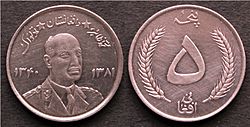 |
|
| Obverse: Portrait of Mohammad Zahir Shah with lettering "* محمد ظاهر * دافغانستان" (Mohammad Zahir Afghanistan) on top and "۱۳۴۰-۱۳۸۱" (1381 - 1340). | Reverse: Wheat ear flank on the side and denomination in the centre. Lettering "پنج" (five), "۵" (5) and "افغانی" (Afghanis). |
| Afghani coin from the reign of Zahir Shah, who was king of Afghanistan from 1933 to 1973. This coin was minted in c. 1962, corresponding to Lunar Hijri year 1381 and Solar Hijri year 1340. | |
| 5 afghani (c. 1973) | |
|---|---|
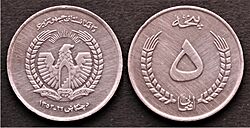 |
|
| Obverse: Emblem of Afghanistan (1974 to 1978 version) surrounded by lettering "د افغانستان جمهوريت" (The Republic of Afghanistan) and "د چنګاښ ۱۳٥۲-۲٦" (Cancer 26th 1352). | Reverse: Denomination surrounded by grain sprig wreath. Lettering "پنجه" (Five), "۵" (5) and "افغانی" (Afghanis). |
| The date on this coin refers to the republican revolution of 1973, corresponding to Solar Hijri year 1352 | |
The first afghani (code: AFA) was introduced in 1923. This happened during the time of King Amanullah Khan. It replaced the old Afghan rupee that had been used since 1891.
For a long time, Afghanistan had two different ways to set its money's value against foreign money. One was an official rate set by banks. The other was a free market rate, decided by how much people wanted to buy or sell money in places like the Saraye Shahzada market in Kabul.
In 1973, one US dollar was worth about 67 afghanis. After a difficult period starting in 1992, the value of the afghani dropped a lot. By 1992, one US dollar could buy 16,000 afghanis. Old banknotes from the time of Mohammed Zahir Shah were no longer valid money by 1991.
During this time, different groups in Afghanistan printed their own afghani banknotes. This caused a lot of confusion and made the money less stable.
In December 1996, a new government took control. The head of their central bank said that most afghani notes were worthless. He also stopped the company that was printing the money from sending more. At this time, one US dollar was worth 21,000 afghanis, and it later dropped to 43,000 afghanis.
By late 2001 and early 2002, the afghani's value changed wildly. In September 2001, one US dollar was 73,000 afghanis. After a new government was formed in December 2001, it went up to 23,000 afghanis per dollar. But then it fell again to 36,000 afghanis in January 2002. There were about seven different versions of the money being used at the same time.
The Second Afghani (2002–Present)
In 2002, Afghanistan got a new afghani currency, with a new code: AFN. This was done to make the economy more stable and stop prices from rising too fast. The new banknotes were printed in Germany.
President Hamid Karzai announced the new money on September 4, 2002, and it started being used on October 8, 2002. People liked this change because it brought a sense of security and stability. For the first time in many years, the central bank was in charge of all the money, not different groups. Most of the old banknotes were destroyed by the end of 2002.
Da Afghanistan Bank now lets the value of the afghani change freely based on the market. When it was first introduced, the new afghani was worth about 43 afghanis to one US dollar.
The afghani's value became more stable over time. This showed that people trusted the new money more. By 2009, it was about 45 afghanis to one US dollar. In 2019, it reached 75 afghanis to the US dollar.
After changes in government in 2021, Afghanistan's money held in other countries was frozen. This caused the afghani's value to fall. The new government then banned all foreign money to encourage people to use only the afghani. In late 2023, the afghani became one of the best-performing currencies in the world, gaining more than 9% against the US dollar.
Coins of the Afghani
New coins were introduced in 2005. These coins come in values of Af. 1, Afs. 2, and Afs. 5.
| Coins of the Afghani | ||||||||||||
|---|---|---|---|---|---|---|---|---|---|---|---|---|
| Obverse | Reverse | Value | Technical parameters | Description | ||||||||
| Diameter | Mass | Composition | Edge | Obverse | Reverse | |||||||
 |
Af. 1 (1961) |
23 mm | 4.0 g | Nickel clad steel | Reeded | Wheat, country name and year. Lettering "افغانستان" (Afghanistan), "١٣٤٠" (Year 1340 as per Afghan calendar i.e. 1961 A.D). |
Denomination surrounded with star at periphery. Lettering "یوة ١ افغاني" (One Afghani). |
|||||
 |
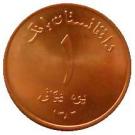 |
Af. 1 | 20 mm | 3.25 g | Copper-plated steel | Smooth | Coat of arms of Afghanistan | Denomination and year | ||||
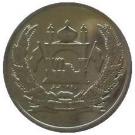 |
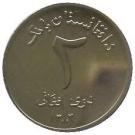 |
Afs. 2 | 22 mm | 4.1 g | Stainless Steel | |||||||
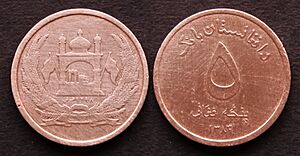 |
Afs. 5 | 24 mm | 5.08 g | Brass | Reeded | |||||||
Banknotes of the Afghani
Between 1925 and 1928, the first paper money was introduced in values of Afs. 5, Afs. 10, and Afs. 50. Later, Afs. 2, Afs. 20, and Afs. 100 notes were added. In 1939, the Bank of Afghanistan (Da Afghanistan Bank) started printing banknotes. They issued notes for Afs. 2, Afs. 5, Afs. 10, Afs. 20, Afs. 50, Afs. 100, Afs. 500, and Afs. 1,000. The Afs. 2 and Afs. 5 notes were replaced by coins in 1958. In 1993, larger notes of Afs. 5,000 and Afs. 10,000 were introduced.
The Afs. 10,000 banknote from 1993 shows what looks like a "pothole cave" or "mouth of a shaft" in a hillside. This is above an old gateway at the ruins near Lashkar Gah. It might be an entrance to underground areas at Qala-e-Bost.
On October 7, 2002, new banknotes were introduced. These included Af. 1, Afs. 2, Afs. 5, Afs. 10, Afs. 20, Afs. 50, Afs. 100, Afs. 500, and Afs. 1,000. The smaller notes (Af. 1, Afs. 2, and Afs. 5) were replaced by coins in 2005. Over the years, security features on the notes were improved to prevent fake money. In 2014, a new Afs. 1,000 note was released for this reason.
| 2002 Series | |||||||
|---|---|---|---|---|---|---|---|
| Image | Value | Dimensions | Main Color | Description | |||
| Obverse | Reverse | Obverse | Reverse | ||||
 |
 |
Af. 1 | 131 × 55 mm | Pink | Seal of Da Afghanistan Bank with Eucratides I-era coin. | Mosque in Mazar-i-Sharif | |
| [1] | [2] | Afs. 2 | Blue | Taq-e Zafar | |||
| [3] | [4] | Afs. 5 | Brown | Bala Hissar fortress | |||
| [5] | [6] | Afs. 10 | 136 × 56 mm | Yellow green | Ahmad Shah Durrani mausoleum, Kandahar | Taq-e Zafar and Lion Gate | |
| [7] | [8] | Afs. 20 | 140 × 58 mm | Brown | Mahmud of Ghazni's Tomb | Arg King's Palace | |
 |
[9] | Afs. 50 | 144 × 60 mm | Dark green | Shah-Do Shamshira Mosque | Salang Pass | |
| [10] | [11] | Afs. 100 | 148 × 62 mm | Violet | Pul-e Khishti Mosque | Qala-e-Bost | |
| [12] | [13] | Afs. 500 | 152 × 64 mm | Blue | Great Mosque of Herat | Kandahar International Airport tower | |
| [14] | [15] | Afs. 1,000 | 156 × 66 mm | Orange | Shrine of Ali, Mazar-i-Sharif | Tomb of Ahmad Shah Durrani | |
Afghani Exchange Rate
The table below shows how the afghani's value has changed compared to the United States dollar since 1950. The "free-market exchange rate" is what people paid in open markets. The "official exchange rate" was set by the government or banks.
| Afghani exchange rate (Local Currency Units per US Dollar) | ||
|---|---|---|
| Date | Free-market exchange rate | Official exchange rate |
| 1950 | 39.0 | |
| 1960 | 40.8 | 17.7 |
| 1970 | 84.8 | 39.9 |
| 1980 | 39.2 | |
| 2003 | 49.0 | 49.0 |
| 2010 | 45.2 | 45.2 |
| 2015 | 68 | 68 |
| 2019 | 75 | 75 |
| 2023 | 70 | 70 |
| Current AFN exchange rates | |
|---|---|
| From Google Finance: | AUD CAD CHF EUR GBP HKD JPY USD |
| From Yahoo! Finance: | AUD CAD CHF EUR GBP HKD JPY USD |
| From XE.com: | AUD CAD CHF EUR GBP HKD JPY USD |
| From OANDA: | AUD CAD CHF EUR GBP HKD JPY USD |
| From fxtop.com: | AUD CAD CHF EUR GBP HKD JPY USD |
See also
 In Spanish: Afgani afgano para niños
In Spanish: Afgani afgano para niños
- Economy of Afghanistan


















